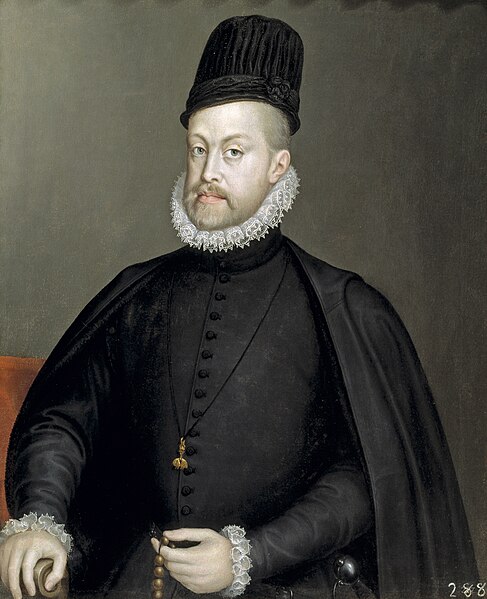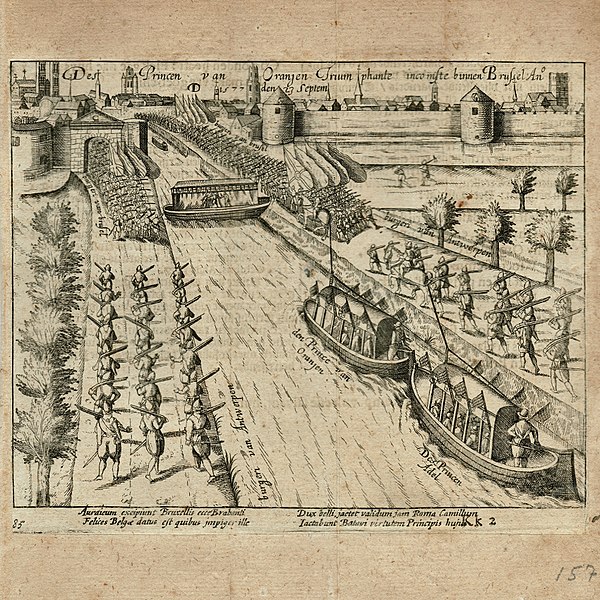 |
| Philip II of Spain |
The Perpetual Edict
Don Juan did not learn the lesson, ignoring the power of
the burghers his focus remained fixed on the nobility. He did however accept
the Union of Brussels, leaving William with little to rebel against. Don Juan
offered to comply with the majority of the rebel demands, but his final
intention, as evidenced in his letters to Spain, was to hand back control of
the Netherlands to Philip. Much to Don Juan’s dismay his letters were intercepted
and used as propaganda for the rebels. The Spaniards claimed them as forgeries.
Queen
Elizabeth let it be known that in her opinion William was;
‘The only man fit to be
employed in so weighty a cause; without whose assistance she cannot hope that
her affairs can take good success.’[i]
Even so Don Juan was able to pacify the delegates from the south and he signed
the Perpetual Edict of Peace on 7th February 1577. The edict was
countersigned by all the provinces apart from Holland and Zealand; Don Juan was
now the accepted Governor of the Netherlands.
Don Juan’s
finessing of the Estates General dealt with the two most important aspects of
rebel demands; he’d agreed to the removal of the Spanish troops and had agreed
that a solution to the religious question was imperative. William’s policy of
building up the power of the Estates General meant that Don Juan was dependent
on the Estates ratifying his decisions in a way no previous Governor had been.
English Support
Both the
religious question and the removal of Spanish troops from the Low Countries
were matters on which Don Juan had no intention of keeping his word. He was
surreptitiously taking control of key positions in the country. Every time he
did this William pointed this out to the Estates General and expressed his
doubts about Spanish intentions. Eventually he moved his own men into the
fortress at Gertrudenberg in the late spring of 1577.
 |
| Robert Dudley, Earl of Leicester |
Don Juan
immediately accused William of breaking the terms of the Pacification of Ghent.
He tried and failed to trick William, who was suffering from a tertian fever, into declaring against the Perpetual Edict. Don Juan’s
popularity turned out to be ephemeral as it became clear that he could not or
would not fulfil his promises about removing the troops and finding a solution
to the religious question. William wrote to one of Don Juan’s appointees;
‘We see now that you on your
side are not keeping faith, that not one clause of the Pacification has been
carried out, nay that you infringe it daily more and more as if it had never
been made and sworn.’[ii]
Charlotte
gave birth to her and William’s second child, Elisabeth van Nassau, on 26th April 1577. Queen
Elizabeth agreed to be her namesake’s godmother and sent presents via the Earl of Leicester who was eager to play a part in
supporting the rebels; a jewel encrusted golden dove for Charlotte and a golden
lizard for William. Elisabeth was christened on 30th May 1577 and Philip Sidney, Leicester’s nephew, stood as proxy for his uncle. And like
his uncle Sidney was an enthusiastic supporter of the rebels.
Breaking the Pacification of Ghent
I
n July
1577, following a meeting at Spa with Margot of Navarre[iii], whose brother the Duke of Anjou had his eye on the provinces for
himself, Don Juan and his troops rushed the citadel at Namur, breaking the Pacification of Ghent
as well as his own Perpetual Edict. Don Juan denounced William and the Estates
General for committing treason against Philip. The provinces rose up against
the Spanish provocation; Don Juan had failed to gauge the depth of hatred that
the Dutch had for their Spanish overlords.
_by_Nicholas_Hilliard.jpg/480px-Marguerite_of_Valois%2C_Queen_of_Navarre)_by_Nicholas_Hilliard.jpg) |
| Margot of Navarre |
The Spanish
troops were few and far between and the towns and villages rose up; Antwerp led
the way, its citizens razing the citadel. William was called south by the
Estates General and, worried about his northern provinces, he reluctantly
obliged. His former estate at Breda, stripped bare by the Spanish, was returned
to him and William started planning for Charlotte and all his children[iv], now at Middelburg, to
join him. Charlotte wrote to him of her step-children;
‘We love each other very
much and are very happy together.’[v]
On 18th
September William entered Antwerp, surrounded by crowds of cheering citizens.
Despite being begged to stay, William made his way on to Brussels where he was
welcomed by, among others, the Duke of Aerschot and his son, both prominent
supporters of Don Juan. William once again took possession of the Palace of
Nassau, another of his properties gutted by the Spanish,
Provincial Splits
William
hoped to reconcile the northern and southern provinces in the uprising against
the Spanish crown. The northern provinces, where the Calvinists had taken
control of the machinery of government, tended towards Protestantism and spoke
Flemish, while the southern provinces remained Catholic and were Flemish or
French speakers[vi].
The south was wary of William’s Calvinism.
 |
| William's entry into Brussels |
William took
his place in the Estates General and refused the offer of Governor of the
Netherlands when it was offered to him. The Estates General sent the Marquis d’Havré to England to ask for aid; Elizabeth
was most accommodating[vii]. On 29th
September she agreed to a further loan of £100,000[viii] and offered 1,000
cavalry and 5,000 foot soldiers under Leicester’s command. The Estates General
thanked her for the loan but wrote querying the wisdom of sending troops at the
onset of winter when warfare stalled.
 |
| Capture of Duke of Aerschot |
Aerschot and
his fellow travellers were suspicious of William’s motives and, jealous of
William, they invited the Holy Roman Emperor’s brother Matthias[ix] to replace Don Juan as governor.
Leicester was discouraged at the splits between the rebels;
‘If they show themselves
thus irresolute, for my part I [would] rather…..abide the worst at home than
hazard life and hand with such unstable men abroad.’[x]
Aerschot,
upon being requested to restore the ancient privileges of Ghent by two
prominent citizens, immediately refused to please a crowd of ‘rascally burghers’ and claimed that he would
not do it even if the Prince of Orange supported them. The citizens of Ghent
were aroused to wrath and broke into Aerschot’s house and dragged him off and
locked him up in the citadel.
William did
not rush to have his opponent released until he’d pressured Aerschot to resign
his Stadtholdership in Flanders. But the Calvinists who replaced Aerschot as
rulers of Ghent went overboard and their punitive actions against Catholics
raised fears in the other southern provinces of the potential problems in a
joint Netherlands ruled by Calvinists.
Choices
 |
| Alessandro Farnese |
Archduke
Matthias arrived in the Netherlands on 8th October 1577 and found
himself being played by William against Don Juan quartered in Luxembourg. Over
the winter it seemed distinctly possible that Philip would hand over control of
the Netherlands to his young cousin.
But William
had another possibility on hand as ruler of the provinces, the Duke of Anjou,
brother of the King of France. Catholic, vain and dishonest, Anjou could barely
have been a worse choice to rule William’s homeland.
The autumn
of 1577 saw a further 20,000 Spanish troops brought in to retaliate against the
Dutch provocation towards their Spanish rulers. They were commanded by Philip’s
nephew, Alessandro Farnese[xi], Prince of
Parma. English spies reported back home;
In view of the threat imbued by Parma, a gifted military
commander, William agreed to the easily led Matthias being made governor of the
provinces.
On 9th
January 1578 William escorted Matthias from Antwerp to Brussels and presented
him to the Estates General. William was the first of the nobles to swear
fealty. Eleven days later Parma attacked the rebels’ army camp at Gembloux while the officers were celebrating in Brussels. The resultant battle was a walkover for the Spanish and a
death knell for the rebels’ unity.
Bibliography
The Age of
Religious Wars – Richard S Dunn, Weidenfeld & Nicholson 1971
The Revolt
of the Netherlands – Pieter Geyl, Cassell History 1988
The Spanish
Inquisition – Henry Kamen, Phoenix 1998
Philip of
Spain – Henry Kamen, Yale University Press 1998
The Spanish
Armada – Colin Martin and Geoffrey Parker, Guild Publishing 1988
The Grand
Strategy of Philip II – Geoffrey Parker, Yale University Press 1998
Elizabeth –
Anne Somerset, Phoenix Giant 1999
William the
Silent – CV Wedgewood, Readers Union Ltd 1945
www.wikipedia.en
[i]
Elizabeth - Somerset
[ii]
William the Silent - Wedgewood
[iii]
Wife of the future Henri IV of France
[iv]
Apart from Philip William still interned in Spain
[v]
William the Silent - Wedgewood
[vii]
It is believed that the Dutch had passed copies of Don Juan’s plans to invade
England to the English
[viii]
In 2014
the relative: historic opportunity cost
of that project is £25,400,000.00 labour cost of that
project is £331,900,000.00 economic cost of that project
is £10,120,000,000.00 www.measuringworth.com
[ix]
Future Holy Roman Emperor
[x]
Elizabeth - Somerset
[xi]
Son of Margaret of Parma
[xii]
William the Silent - Wedgewood
No comments:
Post a Comment
Note: only a member of this blog may post a comment.